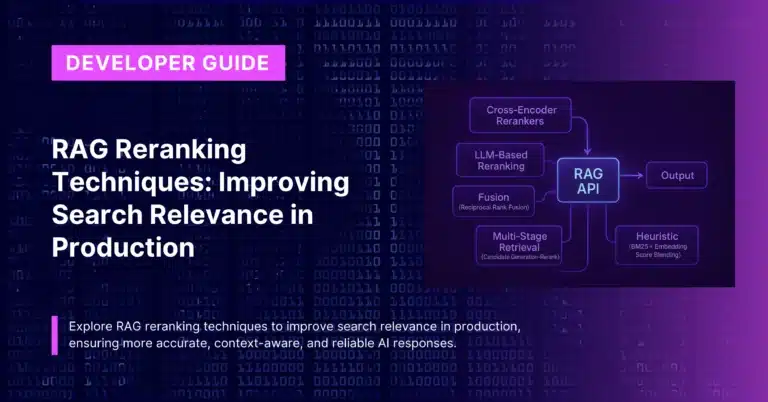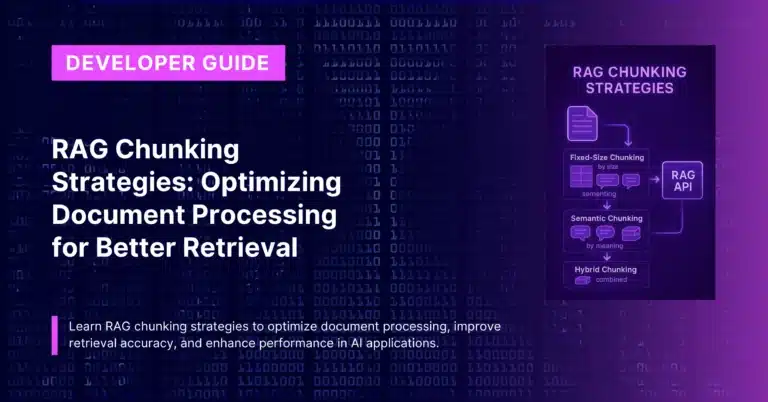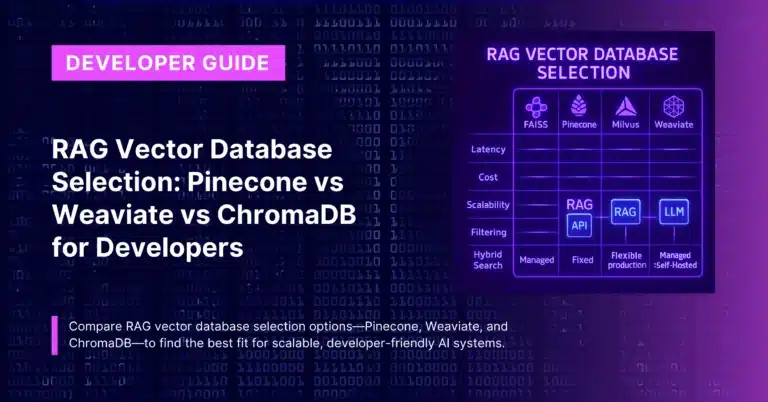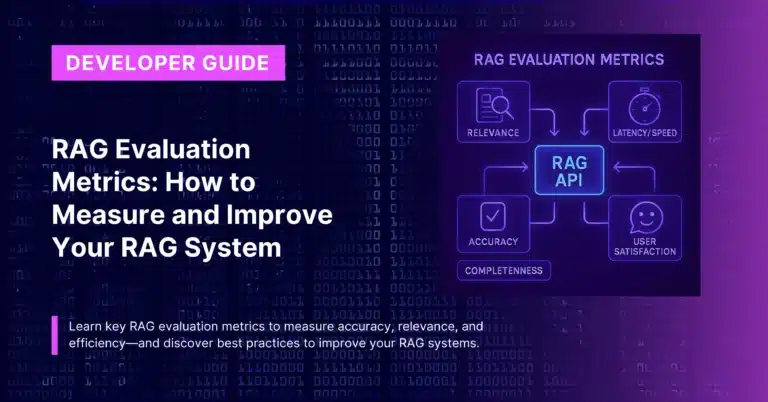
TL;DR
- RAG vs Prompt Engineering: Prompt Engineering optimizes LLM responses through careful input crafting and works best for creative tasks and consistent formatting.
- RAG provides access to external knowledge and real-time data, making it ideal for factual queries and information-heavy applications.
- Most production systems benefit from combining both approaches: prompt engineering to guide RAG retrieval and generation quality.
As Large Language Models (LLMs) become central to business applications, developers face a fundamental question: how do you enhance model performance for specific use cases?
Two primary approaches dominate the landscape—Prompt Engineering and Retrieval-Augmented Generation (RAG)—each addressing different limitations of base LLMs.
The choice between these approaches isn’t merely technical; it affects development speed, operational costs, accuracy requirements, and long-term maintainability.
Understanding when to use each method, or how to combine them effectively, can determine whether your AI application delivers real business value or becomes a costly experiment.
Understanding the Core Approaches
What is Prompt Engineering?
Prompt Engineering involves crafting specific instructions, context, and examples to guide LLM behavior without changing the underlying model. This approach works by:
- Designing strategic inputs that leverage the model’s existing knowledge
- Providing context and examples to shape response format and style
- Using techniques like few-shot learning, chain-of-thought reasoning, and role-based prompts
- Optimizing instructions iteratively based on output quality
The model’s knowledge remains limited to its training data, but careful input design can dramatically improve response quality, consistency, and task-specific performance.
What is RAG (Retrieval-Augmented Generation)?
RAG enhances LLM capabilities by connecting them to external knowledge sources. The process involves:
- Retrieving relevant information from databases, APIs, or document collections
- Injecting retrieved context into the model’s prompt
- Generating responses that combine the model’s reasoning with external data
- Providing access to information beyond the model’s training cutoff
RAG fundamentally expands what the model “knows” by providing real-time access to updated and domain-specific information.
Technical Implementation Differences
Prompt Engineering Implementation
Core Components:
- Prompt templates with structured instructions
- Example libraries for few-shot learning
- Validation systems for output quality control
- A/B testing frameworks for prompt optimization
Implementation Complexity: Low to Medium
Development Time: Hours to days for initial implementation
Maintenance: Ongoing prompt optimization and example curation
Basic Prompt Engineering Pattern:
# Structured prompt with clear instructions
prompt_template = """
Role: You are a technical documentation expert.
Task: Convert the following technical specification into user-friendly documentation.
Guidelines:
- Use simple language for complex concepts
- Include practical examples
- Structure with clear headings
- Maximum 500 words
Input: {technical_spec}
Documentation:
"""
response = llm.generate(
prompt_template.format(technical_spec=user_input)
)RAG Implementation
Core Components:
- Vector database for document storage and retrieval
- Embedding models for semantic search
- Retrieval pipeline with ranking and filtering
- Generation pipeline combining context with LLM responses
Implementation Complexity: Medium to High
Development Time: Weeks to months for production systems
Maintenance: Data updates, retrieval optimization, and prompt tuning
Basic RAG Pattern:
# Retrieve relevant context, then generate
def rag_response(user_query):
# Semantic retrieval
relevant_docs = vector_db.similarity_search(
embedding_model.encode(user_query),
top_k=5
)
# Context-augmented generation
context = "\n".join([doc.content for doc in relevant_docs])
prompt = f"""
Context: {context}
Question: {user_query}
Provide a detailed answer based on the context above.
"""
return llm.generate(prompt)When to Choose Each Approach
Prompt Engineering is Ideal For:
Creative and Open-ended Tasks:
- Content creation (blog posts, marketing copy, creative writing)
- Code generation and refactoring
- Data analysis and interpretation
- Format conversion and transformation
Consistent Output Requirements:
- Structured data extraction from unstructured text
- Standardized report generation
- API response formatting
- Classification and labeling tasks
Resource-Constrained Environments:
- Rapid prototyping and MVP development
- Budget-limited projects
- Simple use cases without external data needs
- Testing and validation scenarios
Technical Prerequisites:
- Basic understanding of LLM capabilities and limitations
- Familiarity with prompt design patterns
- Ability to iterate and test different approaches
- No specialized infrastructure requirements
RAG is Essential For:
Knowledge-Intensive Applications:
- Customer support systems with extensive documentation
- Research assistants requiring current information
- Technical Q&A systems with evolving knowledge bases
- Educational platforms with comprehensive content libraries
Real-time Information Requirements:
- Financial analysis with current market data
- News and current events applications
- Product catalogs with frequent updates
- Regulatory compliance with changing requirements
Domain-Specific Expertise:
- Medical diagnosis support with latest research
- Legal analysis with current case law and regulations
- Engineering solutions with technical specifications
- Scientific applications requiring specialized knowledge
Technical Prerequisites:
- Understanding of vector databases and embedding models
- Experience with document processing and chunking strategies
- Familiarity with information retrieval concepts
- Infrastructure for managing and updating knowledge bases
Performance and Cost Comparison
Prompt Engineering Performance
Advantages:
- Low latency: Single API call to LLM
- Predictable costs: Fixed per-query pricing
- Simple scaling: Linear cost increase with usage
- No infrastructure overhead: Uses existing LLM APIs
Cost Structure:
- Development: 20-100 hours for optimization
- Operations: $0.001-0.02 per query (LLM API costs only)
- Maintenance: Minimal ongoing costs
Example Costs for 10,000 monthly queries:
- GPT-4: ~$200-400/month
- Claude Sonnet: ~$150-300/month
- Open-source models (local): ~$50-100/month in compute
RAG System Performance
Considerations:
- Higher latency: Retrieval + generation pipeline
- Variable costs: Dependent on retrieval frequency and data volume
- Complex scaling: Multiple system components
- Infrastructure requirements: Vector databases and embedding services
Cost Structure:
- Development: 100-400 hours including data preparation
- Operations: $0.01-0.10 per query (retrieval + generation)
- Maintenance: Data updates and system optimization
Example Costs for 10,000 monthly queries:
- Vector database: $100-500/month
- Embedding APIs: $50-200/month
- LLM API calls: $200-800/month
- Total: $350-1,500/month
Implementation Best Practices
Advanced Prompt Engineering Techniques
Few-Shot Learning: Provide 2-5 examples of input-output pairs to guide model behavior:
prompt = """
Examples of sentiment analysis:
Input: "I love this product!"
Output: POSITIVE (0.9)
Input: "It's okay, nothing special."
Output: NEUTRAL (0.1)
Input: "Terrible experience, would not recommend."
Output: NEGATIVE (-0.8)
Input: "{user_text}"
Output:
"""Chain-of-Thought Reasoning: Guide the model through step-by-step problem-solving:
prompt = """
Problem: Calculate the total cost including tax.
Step 1: Identify the base price
Step 2: Calculate tax amount (base price × tax rate)
Step 3: Add base price and tax for total
Now solve: Item costs $50, tax rate is 8.5%
"""Role-Based Prompting: Establish specific expertise and context:
prompt = """
You are a senior software architect with 15 years of experience in
distributed systems. A junior developer asks:
"{user_question}"
Provide a detailed technical explanation with practical examples.
"""RAG System Optimization
Retrieval Quality Improvement:
- Chunk size optimization: Test 200-1000 token chunks for your domain
- Embedding model selection: Choose models trained on similar data
- Query expansion: Add synonyms and related terms to improve recall
- Reranking: Use cross-encoders for better relevance scoring
Context Management:
- Token limit awareness: Ensure retrieved context fits within LLM limits
- Source attribution: Track which documents contribute to responses
- Relevance filtering: Set similarity thresholds to exclude poor matches
- Dynamic context size: Adjust based on query complexity
Generation Quality Controls:
- Prompt engineering for RAG: Guide how the model uses retrieved information
- Factual consistency: Validate generated responses against source material
- Hallucination detection: Implement checks for unsupported claims
- Response validation: Ensure answers address the specific question asked
The Synergistic Approach: Combining Both Methods
Most successful AI applications leverage both prompt engineering AND RAG in complementary ways:
Prompt Engineering for RAG Systems
Retrieval-Specific Prompts:
retrieval_prompt = """
Based on the following documents, provide a comprehensive answer to the user's question.
Requirements:
- Cite specific sources using [Document X] format
- If information is missing, state what you cannot determine
- Distinguish between facts from sources and your reasoning
- Provide confidence levels for key claims
Documents: {retrieved_context}
Question: {user_question}
Answer:
"""Multi-Step RAG with Prompt Engineering:
- Query analysis prompt to understand information needs
- Retrieval optimization using query expansion techniques
- Source evaluation prompt to assess document relevance
- Synthesis prompt to combine information coherently
Implementation Strategy
Phase 1: Start with Prompt Engineering
- Develop basic prompts for your use case
- Test with representative queries and edge cases
- Establish quality baselines and user feedback loops
- Identify limitations in model knowledge
Phase 2: Add RAG Capabilities
- Implement retrieval system for knowledge gaps
- Integrate external data sources gradually
- Use prompt engineering to guide RAG output quality
- A/B test pure prompt vs. RAG-enhanced responses
Phase 3: Optimize the Combined System
- Fine-tune retrieval parameters based on user feedback
- Develop specialized prompts for different types of retrieved content
- Implement fallback strategies when retrieval fails
- Monitor and improve both retrieval and generation quality
Real-World Application Examples
Customer Support Chatbot
Prompt Engineering Component:
support_prompt = """
You are a helpful customer service representative. Respond professionally
and empathetically. If you cannot resolve an issue, escalate to human support.
Current conversation: {conversation_history}
Customer message: {user_message}
Response guidelines:
- Acknowledge the customer's concern
- Provide clear, actionable steps
- Ask clarifying questions if needed
- Offer alternative solutions
Response:
"""RAG Component: Retrieves relevant information from:
- Product documentation
- Common issues database
- Policy and procedure documents
- Previous successful resolutions
Technical Documentation Assistant
Prompt Engineering Component: Structures responses with clear explanations, code examples, and troubleshooting steps.
RAG Component: Accesses current documentation, API references, changelog data, and community discussions.
Combined Result: Generates comprehensive, up-to-date technical guidance that maintains consistent formatting while incorporating the latest information.
Decision Framework: Choosing Your Approach
Use Prompt Engineering Alone When:
✅ Model’s training data covers your domain adequately
✅ Creative or interpretive tasks are primary use cases
✅ Consistent formatting and style are more important than factual updates
✅ Development speed and cost minimization are priorities
✅ No external data sources are required
Use RAG When:
✅ Information changes frequently or exists beyond model training cutoff
✅ Domain-specific knowledge not well-represented in training data
✅ Users need citations and source attribution
✅ Accuracy of factual information is critical
✅ Multiple data sources must be synthesized
Use Combined Approach When:
✅ Complex applications requiring both reasoning and current information
✅ Multiple user personas with different information needs
✅ Quality and accuracy are paramount
✅ Resources allow for more sophisticated implementation
Getting Started: Practical Implementation
For Prompt Engineering Projects
Essential Tools:
- LLM API access (OpenAI, Anthropic, Cohere, or open-source alternatives)
- Prompt testing and version control systems
- User feedback collection mechanisms
- Performance monitoring and analytics
Development Workflow:
- Define clear objectives and success metrics
- Create initial prompt templates based on use cases
- Test with diverse inputs and edge cases
- Iterate based on output quality and user feedback
- Implement monitoring for production deployment
For RAG Implementation
Infrastructure Requirements: Vector databases, embedding APIs, document processing pipelines, and LLM integration.
Rapid Development Options: The CustomGPT platform provides production-ready RAG infrastructure without the complexity of managing vector databases and embedding models.
Their developer starter kit includes comprehensive documentation, voice features, and multiple deployment options.
Getting Started: Create an account at https://app.customgpt.ai to experiment with their OpenAI-compatible RAG API and explore their integration examples for various platforms.
Monitoring and Optimization
Prompt Engineering Metrics
Quality Indicators:
- Response relevance and accuracy
- Consistency across similar queries
- User satisfaction scores
- Task completion rates
Optimization Process:
- A/B test different prompt variations
- Collect user feedback on response quality
- Monitor edge cases and failure modes
- Version control prompts for rollback capabilities
RAG System Metrics
Retrieval Quality:
- Precision and recall of retrieved documents
- Average relevance scores
- Coverage of user queries
- Time to retrieve relevant information
Generation Quality:
- Factual accuracy against source material
- Response coherence and completeness
- Source attribution accuracy
- User preference in A/B tests
Frequently Asked Questions
Can I start with prompt engineering and add RAG later?
Yes, this is often the recommended approach. Start with prompt engineering to understand your use case requirements and quality expectations. Add RAG when you identify specific knowledge gaps that external data can address. The prompt engineering experience will help you design better RAG prompts.
How do I prevent hallucinations in RAG systems?
Use prompt engineering to explicitly instruct the model to base responses only on provided context. Include phrases like “Based solely on the provided information” and “If the information isn’t in the context, say ‘I don’t know.'” Implement post-generation validation to check factual consistency with source material.
Which approach scales better for large organizations?
RAG typically scales better for knowledge-intensive organizations because it centralizes information management and can incorporate new data without retraining or prompt modifications. However, prompt engineering scales well for consistent formatting and processing tasks across many applications.
How do I handle conflicting information in RAG systems?
Use prompt engineering techniques to instruct the model on handling conflicts. For example: “If the retrieved documents contain conflicting information, present both perspectives and note the sources. If one source is more recent or authoritative, indicate this in your response.”
What’s the best way to combine both approaches?
Start with a solid prompt engineering foundation that defines the AI’s role, response format, and behavior guidelines. Then use RAG to inject current and domain-specific information into this structured framework. The prompt engineering ensures consistent, high-quality output while RAG provides the necessary knowledge depth.
The choice between Prompt Engineering and RAG—or their combination—depends on your specific requirements for knowledge currency, development resources, and application complexity. Both approaches have their place in the AI development toolkit, and the best solutions often leverage the strengths of each method to create robust, user-focused AI applications.
For more RAG API related information:
- CustomGPT.ai’s open-source UI starter kit (custom chat screens, embeddable chat window and floating chatbot on website) with 9 social AI integration bots and its related setup tutorials.
- Find our API sample usage code snippets here.
- Our RAG API’s Postman hosted collection – test the APIs on postman with just 1 click.
- Our Developer API documentation.
- API explainer videos on YouTube and a dev focused playlist.
- Join our bi-weekly developer office hours and our past recordings of the Dev Office Hours.
P.s – Our API endpoints are OpenAI compatible, just replace the API key and endpoint and any OpenAI compatible project works with your RAG data. Find more here.
Wanna try to do something with our Hosted MCPs? Check out the docs for the same.
Priyansh is Developer Relations Advocate who loves technology, writer about them, creates deeply researched content about them.





